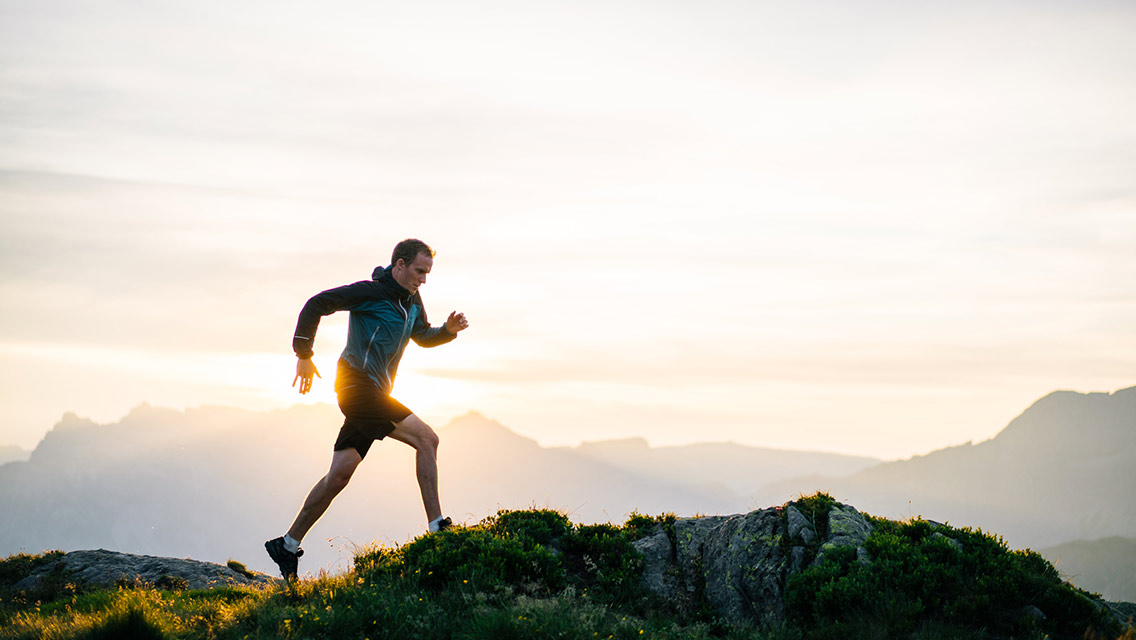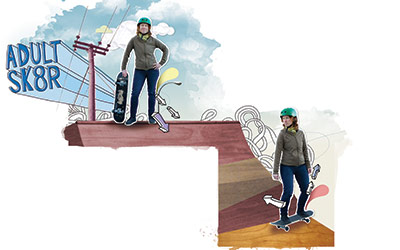Kickflips and heelflips, ollies and nollies: Who hasn’t dreamed of dropping in at a skate park and pulling off some tricks?
Skateboarding delivers surprising physical and mental benefits, along with the incredible cool-factor of zipping up, down, and around concrete ramps, stairs, hills, and more. And it’s gaining traction among grownups — some 6.5 million Americans now ride, according to the Sporting Goods Industry Association.
“Physically, skating will make you acutely aware of your body and how it moves,” says Salena Retsos of Erik’s Bike, Board, and Ski Shop in Bloomington, Minn. “It helps develop muscle memory and quick reflexes for a solid foundation. Skating builds endurance and a commitment to perfecting the aesthetic.”
Skateboarding also develops mental strength, dexterity, and a creative perspective on spatial awareness, she adds. “Building yourself up to jump down a stair set takes as much mental strength to ignore the fear as it does to actually jump.”
As with any sport, practice is key. “Take your board everywhere,” Retsos advises. “Practice tricks in your living room, skate to the corner store, have it with you wherever you go, and it will become second nature.”
Cardio, plyometric moves, and resistance exercises can prepare your muscles for the rigors of riding. “Taking your training into the gym is a great way to reduce the chance of injury and recover faster,” says Retsos.
The mind can also benefit from a few simple at-home exercises, including meditation and visualization.
“Skateboarding is the most radical sport in the world,” says James “Swamp Trog” Kaul, a ramp builder and skateboarding expert at 3rd Lair Skate Park in Golden Valley, Minn. “It takes discipline, strength, and endurance — and it’s a release, no matter what’s happening in your life. It’s truly a medicine you can only experience through participating.”
Technique Tips & Drills
Skateboarding requires core stability, lower-body strength, balance, and power, explains Retsos. These dynamic exercises and functional-strength moves will improve all of them — as well as your performance when you hit the skate park.
Drill 1: Kettlebell Swing
“Skating is core-based,” says Retsos, “so any exercise that builds core strength is essential.” A kettlebell swing requires core engagement while also working the hips, hamstrings, glutes, and lats.
For tips on fine-tuning your kettlebell-swing form, see “BREAK IT DOWN: The Kettlebell Swing.” Start with three sets of 10 reps with a medium to heavy kettlebell. Progress to 10 sets of 10 reps.
Drill 2: Stability-Ball Hamstring Curl
Balance is crucial to maneuvering a skateboard, so Retsos points to a stability ball as an ideal piece of training equipment. This movement helps you stay balanced in a crouched position on the skateboard by strengthening the glutes and hamstrings.
- Lie on your back with legs extended, heels and lower calves atop a stability ball. (Or place your feet on a towel spread out on a smooth surface.)
- Brace your abs and squeeze your glutes to raise your hips into the air without overarching your back.
- With hips up, bend your knees to roll the ball
toward you. - Return to the starting position with control.
- Do three sets of eight to 10 reps.
Drill 3: Jumping Lunges
You need agility (the ability to switch directions quickly) and power (which generates the force necessary to complete many tricks) to skate well. Lower-body plyometrics, such as jumping lunges, target both of these abilities while also building strength and endurance in a bent-leg position.
- Assume a split stance, right leg forward, with both knees softly bent.
- Bend both knees to lower into a split squat.
- When your back knee is about an inch from the ground, push off your front foot and lift your back foot to jump. In midair, switch your feet so that your left leg is now in front.
- Land softly and lower into a split squat.
- Repeat, alternating sides for 20 seconds, then rest 20 seconds. Perform three or four sets.
(See more plyo moves at “Jump Around: A Plyometric Workout.”)
Drill 4: The ABCs of Riding
Your feet are an extension of the skateboard — they control each and every move. Kaul advises skaters to perform the following warm-up before every session. If you are warming up near the edge of a ramp, make sure you’re out of the way of other riders.
- Sitting down, draw the alphabet — A to Z — in the air with the big toe of one foot. Aim to be precise and move your ankle. Repeat on the opposite side.
- Stand up and draw the letters again while balancing on one leg, then switch sides. Focus on grounding through your standing leg and extending through the big toe. Don’t rush.
Mind the Mental Game
Fear is the primary obstacle to improving your boarding game, says Kaul. This feeling is natural, he explains, but the key is not to panic. He offers the following advice to keep freakouts at bay.
Play it cool. Avoid sudden movements. Visualize your tricks before you attempt them, and execute with intention and control.
Stay low. “The lower you are to the ground, the softer you fall,” says Kaul. Maintain an athletic stance with knees bent; don’t lock out your limbs.
Breathe. Don’t hold your breath, even if you’re scared or uncertain. Practice exhaling during a trick.
“There is no wrong way to ride a skateboard,” Kaul says. You’ve got this.|
This originally appeared as “Let the Good Times Roll” in the July-August 2020 print issue of Experience Life.




This Post Has 0 Comments